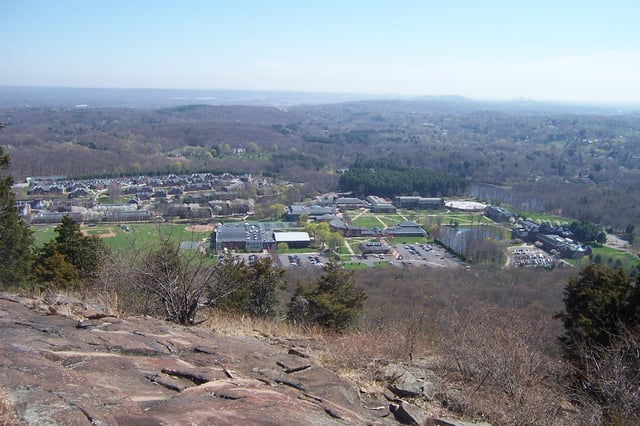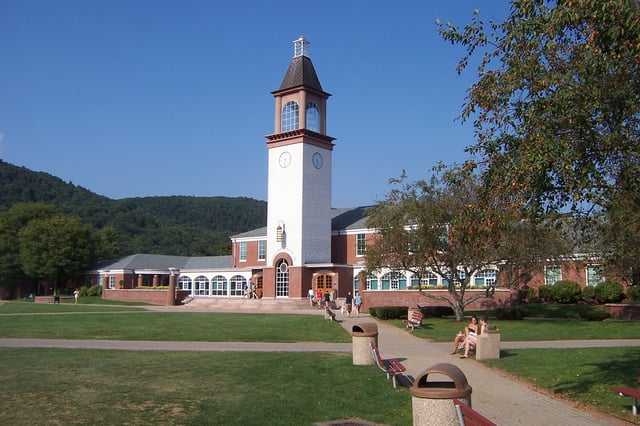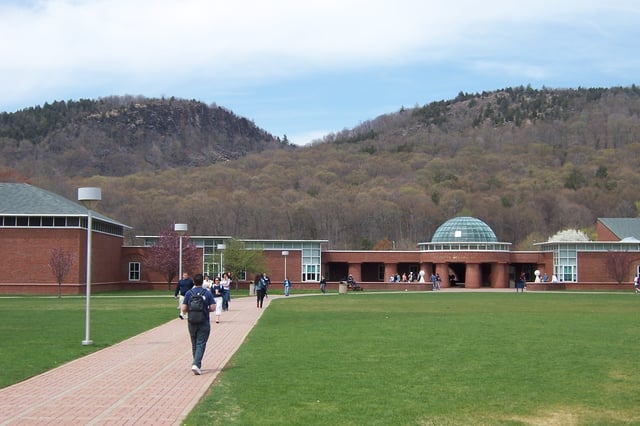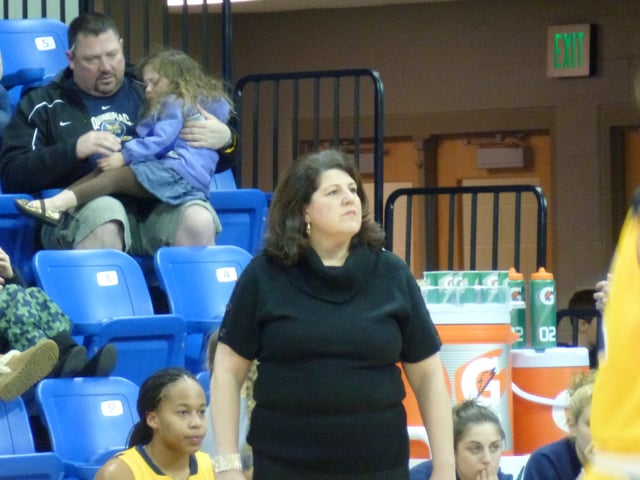Quinnipiac University

Quinnipiac University

| Connecticut College of Commerce | |
| Motto | Qui Transtulit Sustinet(Latin)[1] |
| "He who transplants, sustains"[1] | |
| Type | Private |
| Established | 1929 |
| Endowment | $526.6 million (2018)[2] |
| Chairman | William C. Weldon |
| President | Judy D. Olian |
| 350 full-time | |
| Students | 10,207 (2018)[3] |
| Undergraduates | 7,425 (2018)[3] |
| Postgraduates | 2,782 (2018)[3] |
| Location | |
| Campus | Suburban |
| Colors | Navy,gold, and sky blue[1][5][6] |
| Athletics | NCAADivision I–MAACECAC HockeyBig East– Field hockey |
| Nickname | Bobcats |
| Affiliations | NAICUNEASC |
| Sports | 21 varsity teams[7] |
| Mascot | Boomer the Bobcat |
| Website | https://www.qu.edu[53] |
| University rankings | |
| National | |
| Forbes[24] | 215 |
| Times/WSJ[25] | 261 |
| U.S. News & World Report[26] | 153 |
| Washington Monthly[27] | 283 |
Quinnipiac University (/ˈkwɪnɪpiæk/[8]) is a private university in Hamden, Connecticut. The university grants undergraduate, graduate, and professional degrees through its College of Arts and Sciences, School of Business and Engineering, School of Communication, School of Health Sciences, School of Law, School of Medicine, School of Nursing, and School of Education. The university also hosts the Quinnipiac University Polling Institute.
| Connecticut College of Commerce | |
| Motto | Qui Transtulit Sustinet(Latin)[1] |
| "He who transplants, sustains"[1] | |
| Type | Private |
| Established | 1929 |
| Endowment | $526.6 million (2018)[2] |
| Chairman | William C. Weldon |
| President | Judy D. Olian |
| 350 full-time | |
| Students | 10,207 (2018)[3] |
| Undergraduates | 7,425 (2018)[3] |
| Postgraduates | 2,782 (2018)[3] |
| Location | |
| Campus | Suburban |
| Colors | Navy,gold, and sky blue[1][5][6] |
| Athletics | NCAADivision I–MAACECAC HockeyBig East– Field hockey |
| Nickname | Bobcats |
| Affiliations | NAICUNEASC |
| Sports | 21 varsity teams[7] |
| Mascot | Boomer the Bobcat |
| Website | https://www.qu.edu[53] |
| University rankings | |
| National | |
| Forbes[24] | 215 |
| Times/WSJ[25] | 261 |
| U.S. News & World Report[26] | 153 |
| Washington Monthly[27] | 283 |
History

The Mount Carmel campus, from atop Sleeping Giant, April 2009.

Quinnipiac's Arnold Bernhard Library and clock tower, focus of main campus quadrangle, August 2008
What became Quinnipiac University was founded in 1929 by Samuel W. Tator,[9] a business professor and politician.
Phillip Troup, a Yale College graduate, was another founder, and became its first president[9] until his death in 1939. Tator's wife, Irmagarde Tator, a Mount Holyoke College graduate, also played a major role in the fledgling institution's nurturing as its first bursar. Additional founders were E. Wight Bakke, who later became a professor of economics at Yale, and Robert R. Chamberlain, who headed a furniture company in his name.[9]
The new institution was conceived in reaction to Northeastern University's abandonment of its New Haven, Connecticut, program at the onset of the Great Depression. Originally, it was located in New Haven and called the "Connecticut College of Commerce". On opening its doors in 1929, it enrolled under 200, and its first graduating class featured only eight students. At the time, it awarded only associate's degrees. In 1935, the college changed its name to the "Junior College of Commerce".
From 1943 to 1945, the college closed, as nearly its entire student body was drafted into World War II. Upon re-opening, the college's enrollment nearly quadrupled to approximately 800 students.
In 1951, the institution was renamed "Quinnipiac College", in honor of the Quinnipiac Indian tribe that once inhabited Greater New Haven. That same year, Quinnipiac began to confer bachelor's degrees. In 1952, Quinnipiac expanded rapidly, both physically and in terms of curriculum, relocating to a larger campus in New Haven, and also assuming administrative control of Larson College, a private women's college.
In 1966, after having outgrown its campus in New Haven, Quinnipiac moved to its current campus in the Mount Carmel section of Hamden, Connecticut, at the foot of Sleeping Giant Park.[10] During the 1970s, Quinnipiac began to offer master's degrees in a variety of disciplines.
Until the 1990s, Quinnipiac remained primarily a commuter college with only a regional reputation; however, that changed during the next decade.
In 1995, the University of Bridgeport's law school migrated to Quinnipiac and became the Quinnipiac School of Law Center was dedicated.
On July 1, 2000, the college officially changed its name to "Quinnipiac University" to reflect its relatively new breadth in academic offerings.
That same year, Quinnipiac University received accreditation by AACSB.
Student journalism controversy
In 2007 and 2008, Quinnipiac briefly drew national attention over the university's control over student publications and students' speech. In the fall 2007 semester, junior Jason Braff, then-editor of the Quinnipiac Chronicle, the official newspaper of the school, openly criticized a university policy that forbade the Chronicle from publishing news online before the content was published in the weekly print edition. Braff wrote an editorial about the policy and also gave an interview to the local Waterbury paper, Republican-American criticizing it. Manuel Carreiro, Quinnipiac's vice president and dean of students, then sent a letter to Braff in November, telling him that his public disagreement with school policies would "seriously place your position and organization at risk with the university." Braff received an $8,000 annual stipend for his position, and the university said that its employees have more of a responsibility than other students to uphold policies. But Lynn Bushnell, QU's vice president for public affairs, denied threatening to fire Braff for disagreeing with school policies. Braff and the Chronicle staff were also openly critical of a public relations policy requiring all news media inquiries and questions (including those from the Chronicle) for administrators to be sent, via e-mail, to the university's public relations department.[11]
Quinnipiac officials agreed to discuss the policies with students, and eventually decided that making the Chronicle independent from the university was the best idea. The school set forth a plan of action, which included the university appointing editors for the 2008–2009 academic year. Angry with this plan, Braff and other staff agreed to leave the Chronicle at the end of the spring 2008 semester, and all applicants for the editor positions withdrew their applications.
Former Chronicle staff members came back in fall 2008 with Quad News, an independent newspaper with only a website and no print edition. Plans were to incorporate Quad News as its own business venture run on advertising revenue. Quad News immediately faced opposition from the university. Staff members learned in September that university officials had instructed all varsity coaches, staff and athletes not to speak to Quad News reporters. Shortly after, officials threatened to shut down the university's chapter of the Society of Professional Journalists (SPJ), claiming that they violated school policy by using their meetings as a cover for Quad News meetings. The Quad News staff had met at two SPJ meetings,[12] after the university took away Quad News meeting reservation, citing the fact that the organization was not a university-recognized club. Quad News promptly stopped their meetings with SPJ.[13] The move prompted a public letter from national SPJ leaders, expressing concern over the university's actions. Both staffs recognized the other publication as legitimate and wished each other luck in their friendly competition.[14]
2010 title IX discrimination case
On July 21, 2010, a federal judge ruled that Quinnipiac violated Title IX of the Civil Rights Act of 1964 by failing to provide equal treatment to women's athletic teams. The judge, Stefan Underhill, determined that Quinnipiac's decision to eliminate the women's volleyball team as well as its attempt to treat cheerleading as a competitive sport and its manipulation of reporting with regard to the numbers of male and female athletes amounted to unlawful discrimination against female students. Underhill ruled that competitive cheerleading was currently too underdeveloped and unorganized and then ordered that the school maintain its volleyball program for the 2010-11 season.[15][16]
Academics
Currently, Quinnipiac offers 58 undergraduate majors, 20 graduate programs, and a Juris Doctor program.
Quinnipiac's physician assistant (PA) program is ranked 5th nationally by U.S.
News & World Report.[17] Its Frank H. Netter MD School of Medicine admitted 60 students to its first class in 2013.[18]
The university operates several media outlets, including a professionally run commercial radio station, WQUN, founded by journalist and Quinnipiac professor Lou Adler. The university also operates a student-run FM radio station WQAQ, which concurrently streams on the Internet. An award-winning[19] student-run television station, Q30 Television, is streamed online. Also, a student-produced newspaper, the Chronicle, established in 1929, publishes 2,500 copies every Wednesday. Students also run a literary magazine, the Montage, a yearbook, the Summit, the Quinnipiac Bobcats Sports Network (an online sports-focused broadcast), and the Quinnipiac Barnacle[20] (a parody news organization). Unaffiliated with the school, but run by students, is also an online newspaper, the Quad News.[21]
Quinnipiac is home to one of the world's largest collections of art commemorating the Great Irish Famine. The collection is contained in Ireland’s Great Hunger Museum (Músaem An Ghorta Mhóir) just off the Mount Carmel Campus.[22]
In May 2014, Quinnipiac laid off 16 full-time but non-tenured faculty, with 11 of those from the College of Arts and Sciences, with no advance notice of the staff reduction.
The cuts followed several years of a "stalled hiring" and a faculty salary freeze.
The layoffs were mostly in departments that had experienced reduced enrollment in recent years, and enrollment was expected to be down by 12 percent in the fall 2014 term.[23]
Rankings
Campuses
Quinnipiac University consists of three campuses: the Mount Carmel campus off of Mount Carmel Avenue in Hamden; the York Hill campus off of Sherman Avenue in Hamden, and the North Haven Campus in North Haven, just north of New Haven, Connecticut.
The oldest of these campuses is the Mount Carmel Campus, at the foot of Sleeping Giant State Park.
The Arnold Bernhard Library, Carl Hansen Student Center, university administration, and many of the student residences are found on this campus.
The York Hill Campus, located on a hill about a half-mile from the Mount Carmel Campus, began with the development of the People's United Center. In 2010 this was joined by a new student center as well as expanded parking and residence facilities as part of a $300 million expansion of the 250-acre (1.0 km2) campus.[30] York Hill is a "green" campus, making use of renewable energy and environmentally friendly resources, including one of the first major wind farms integrated into a university campus.[31]
In 2007, Quinnipiac acquired a 100-acre (0.40 km2) campus in North Haven, Connecticut, from Anthem Blue Cross Blue Shield, and has been gradually converting it for use by graduate programs at the university.[32]
Quinnipiac University opened the Frank H. Netter M.D. School of Medicine in 2013.[33]
Buildings and landmarks

Campus and Lender School of Business Center, with Sleeping Giant in background, April 2005
The current buildings on the Mount Carmel campus are:
Carl Hansen Student Center – This facility serves as the home to the student government, WQAQ-FM, the Chronicle and many student organizations. The student bookstore, main dining hall, U.S. Post Office, and a branch of TD Bank are located there as well. Renovated and expanded in 2012, it is home to a number of new meeting, multipurpose, and media rooms for use by student organizations and fraternity and sorority life members.
Arnold Bernhard Library – The library is named for Arnold Bernhard, the founder and former chief executive officer of Value Line, Inc. Bernhard's son made the library renovation possible by donating $1 million for the project and an additional $3 million for the university's endowment in 1997.
The donation was the largest in the university's history.
The signature clock tower was replaced during the renovation which changed the icon of the school, which was a rocket ship spire, to a more conservative, modern tower.
The computer help desk was relocated to the library.
The learning center, renamed the "learning commons", includes a student tutoring program.
Ed McMahon Mass Communications Center – Named for the television announcer and sidekick, who was a long-term financial supporter of the school,[34] the center is a media production facility equipped with up-to-date technology for hands-on training in all aspects of radio, television, journalism and multimedia production. The HDTV studio provides students with a professional environment for creating television programming.
Clarice L. Buckman Center and Theater – Commonly called the "Buckman Center," the building houses a theater used for drama and music performances, classrooms, rehearsal space for theater students, as well as science laboratories.
Echlin Center – Home to the offices of undergraduate admissions, and financial aid.
The second floor houses faculty offices, and two programs in the School of Health Sciences; Athletic Training and Biomedical Science
Lender School of Business Center – Fully accredited by the Association to Advance Collegiate Schools of Business (AACSB) International,[35] the longest standing, accrediting agency for business programs in the world.
The school of business was also included in the 2011 edition of Princeton Review's "Best 300 Business Schools" and in Bloomberg Businessweek's "Top 100 Undergraduate Business Schools" for 2011.
Tator Hall – Part of the student center, it has multiple classrooms and labs, including the new Department of Engineering classrooms.
The Dean Robert W. Evans College of Arts and Sciences Center – Composed of three separate building surrounding a quad.
CAS 1 and CAS 3 are both three floors and contain classrooms, seminar rooms, and faculty offices.
CAS 2 is now the Center of Religion, and opened in the fall of 2017.
It has a student lounge, meeting room, kitchen, and a chapel.
Quinnipiac Polling Institute
Quinnipiac's polling institute receives national recognition for its independent surveys of residents throughout the United States.
It conducts public opinion polls on politics and public policy as a public service as well as for academic research.[36] The poll has been cited by major news outlets throughout North America and Europe, including the Washington Post,[37] Fox News,[38] USA Today,[39] the New York Times,[40] CNN,[41] and Reuters.[42]
The polling operation began informally in 1988 in conjunction with a marketing class.[36] It became formal in 1994 when the university hired a CBS News analyst to assess the data being gained.[36] It subsequently focused on the Northeastern states, gradually expanding during presidential elections to cover swing states as well.[36] The institute receives funding from the university,[36] with its phone callers generally being work study students or local residents. The polls have been rated highly by FiveThirtyEight for accuracy in predicting primary and general elections.[43] However in 2016, Quinnipiac incorrectly predicted a Hillary Clinton "landslide" in the United States presidential election.[44][45]
Greek life
Quinnipiac is home to eight fraternities and nine sororities.[46]
Fraternities
Alpha Epsilon Pi
Delta Tau Delta
Pi Kappa Phi
Delta Upsilon
Beta Theta Pi
Alpha Sigma Phi
Phi Gamma Delta
Sororities
Alpha Chi Omega
Alpha Delta Pi
Kappa Alpha Theta
Phi Sigma Sigma
Sigma Gamma Rho
Pi Beta Phi
Kappa Delta
Chi Omega
Gamma Phi Beta
Delta Delta Delta
The National Panhellenic Conference is an umbrella organization which was created in 1902 for 26 women's sororities. The National Panhellenic Conference at Quinnipiac University serves as an advocate for the sororities involved in the conference with the campus and community. The Panhellenic Conference at Quinnipiac University includes Alpha Chi Omega, Alpha Delta Pi, Kappa Alpha Theta, Phi Sigma Sigma, Pi Beta Phi, Kappa Delta, and Chi Omega.
Athletics

Tricia Fabbri, head coach women's basketball
The Quinnipiac Bobcats, previously the Quinnipiac Braves, comprise the school's athletic teams.
They play in NCAA Division I in the Metro Atlantic Athletic Conference, except for the men's and women's ice hockey teams, which are part of ECAC Hockey, and the women's field hockey team, which joined Big East Conference starting with the 2016 season.[47]
The team with the largest following on campus and in the area is the men's ice hockey team under established coach Rand Pecknold,[49] which has been nationally ranked at times; during the 2009–2010 season they entered the top ten of the national polls for the first time.[50] The team was the number-one nationally ranked hockey program for parts of the 2012-2013 season, reaching the Frozen Four for the first time in the program's history. They advanced to the national championship, ultimately falling to rival Yale.
The Quinnipiac women's ice hockey program had their most success in the 2009–10 NCAA Division I women's ice hockey season. Quinnipiac University added a women's golf and women's rugby team in the 2010–11 academic year.[48]
In the late 2000s the men's basketball team gained a greater following under new head coach Tom Moore, a disciple of UConn Huskies men's basketball coach Jim Calhoun.[49] Both men's and women's ice hockey and basketball teams play at the $52 million People's United Center, opened in 2007.[49] The women's lacrosse team has also been quite strong. Men's cross country captured 4 NEC titles in 5 years between 2004-2008. The athletics program has been under pressures common to other universities, and at the close of the 2008–2009 academic year, men's golf, men's outdoor track, men's indoor track and women's volleyball were dropped as a cost-cutting measure, although the last of these was restored (as a result of a Title IX suit[51]).
Notable alumni
Sam Anas- (born 1993) hockey player for the Iowa Wild
Ryan Cleckner – former army sniper and veteran activist
Evan Conti (born 1993) – basketball player in Israel for Hapoel Be'er Sheva B.C.
John Delaney – Quinnipiac baseball coach
Jared Grasso - Bryant University men's basketball coach
Freddy Hall – goalkeeper for Limerick FC
Eric Hartzell – goalie for the Heilbronner Falken
Themis Klarides – Deputy Minority Leader of the Connecticut House of Representatives
Murray Lender – former businessman and CEO of Lender's Bagels[52]
Molly Qerim – sports anchor and moderator for ESPN's First Take
Bryce Van Brabant – forward for the Calgary Flames
Arnold Voketaitis – former opera singer and teacher (bass-baritone)
William C. Weldon – former CEO of Johnson & Johnson
Turk Wendell – former Major League Baseball player
William D. Euille – former mayor of Alexandria, Virginia.
Mary-Jane Foster – co-founder of the Bridgeport Bluefish.
Connor Clifton — defenseman for the Boston Bruins of the National Hockey League (NHL).